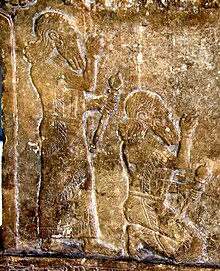Tukulti-Ninurta I
| Tukulti-Ninurta I | |
|---|---|
| |
 Tukulti-Ninurta I depicted both standing and kneeling | |
| King of the Middle Assyrian Empire | |
| Reign | c. 1243–1207 BC[1] |
| Predecessor | Shalmaneser I |
| Successor | Ashur-nadin-apli |
| Issue | Ashur-nadin-apli, Enlil-kudurri-usur |
| Father | Shalmaneser I |
Tukulti-Ninurta I (meaning: "my trust is in [the warrior god] Ninurta"; reigned c. 1243–1207 BC) was a king of Assyria during the Middle Assyrian Empire. He is known as the first king to use the title "King of Kings".
Biography
Tukulti-Ninurta I succeeded
Asia Minor and the Levant. Tukulti-Ninurta I retained Assyrian control of Urartu, and later defeated Kashtiliash IV, the Kassite king of Babylonia, and captured the rival city of Babylon to ensure full Assyrian supremacy over Mesopotamia. He set himself up as king of Babylon, and took on the ancient title "King of Sumer and Akkad" first used by Ur-Nammu
.
Tukulti-Ninurta had petitioned the god
Elamites, who had themselves coveted Babylon. He also wrote an epic poem documenting his wars against Babylon and Elam. After a Babylonian revolt, he raided and plundered the temples in Babylon, regarded as an act of sacrilege to all Mesopotamians, including Assyrians. As relations with the priesthood in Ashur began deteriorating, Tukulti-Ninurta built a new capital city; Kar-Tukulti-Ninurta. However, his sons rebelled against him and besieged him in his new city. During the siege, he was murdered. One of them, Ashur-nadin-apli
, would succeed him on the throne.
After his death, the Assyrian Empire fell into a brief period of stagnation. The Tukulti-Ninurta Epic describes the war between Tukulti-Ninurta I and Kashtiliash IV.[3]
-
Mace with the name of Tukulti-Ninurta I,Louvre Museum
-
Temple altar offered by Tukulti-Ninurta I. 1243-1207 BCE. From Assur, Iraq. Ancient Orient Museum, Istanbul
-
Foundation inscription of the temple of Ishtar at Assur built by Tukulti-Ninurta I. Lead. 1243-1207 BCE. From Iraq. Ancient Orient Museum, Istanbul
-
Campaigns of Tukulti-Ninurta I
Sources
- ISBN 978-9004430914.
- ^ J. M. Munn-Rankin (1975). "Assyrian Military Power, 1300–1200 B.C.", in I. E. S. Edwards (ed.) Cambridge Ancient History, Volume 2, Part 2. Cambridge University Press. pp. 287–288, 298.
- ISBN 978-0-521-08691-2, pg. 284-295
- ^ "stela British Museum". The British Museum.
External links
- Assyrian origins: discoveries at Ashur on the Tigris: antiquities in the Vorderasiatisches Museum, Berlin, an exhibition catalog from The Metropolitan Museum of Art Libraries (fully available online as PDF), which contains material on Tukulti-Ninurta I

![Stela of Tukulti-Ninurta I. Describes how he rebuilt the temple of the goddess Dinitu from its foundations. "I built within a lofty dais and an awesome sanctuary for the abode of the goddess Dinitu, my mistress, and deposited my stelas.". From Assur, northern Iraq.[4]](http://upload.wikimedia.org/wikipedia/commons/thumb/7/79/Assyrian_Cuneiform_Script.jpg/149px-Assyrian_Cuneiform_Script.jpg)



